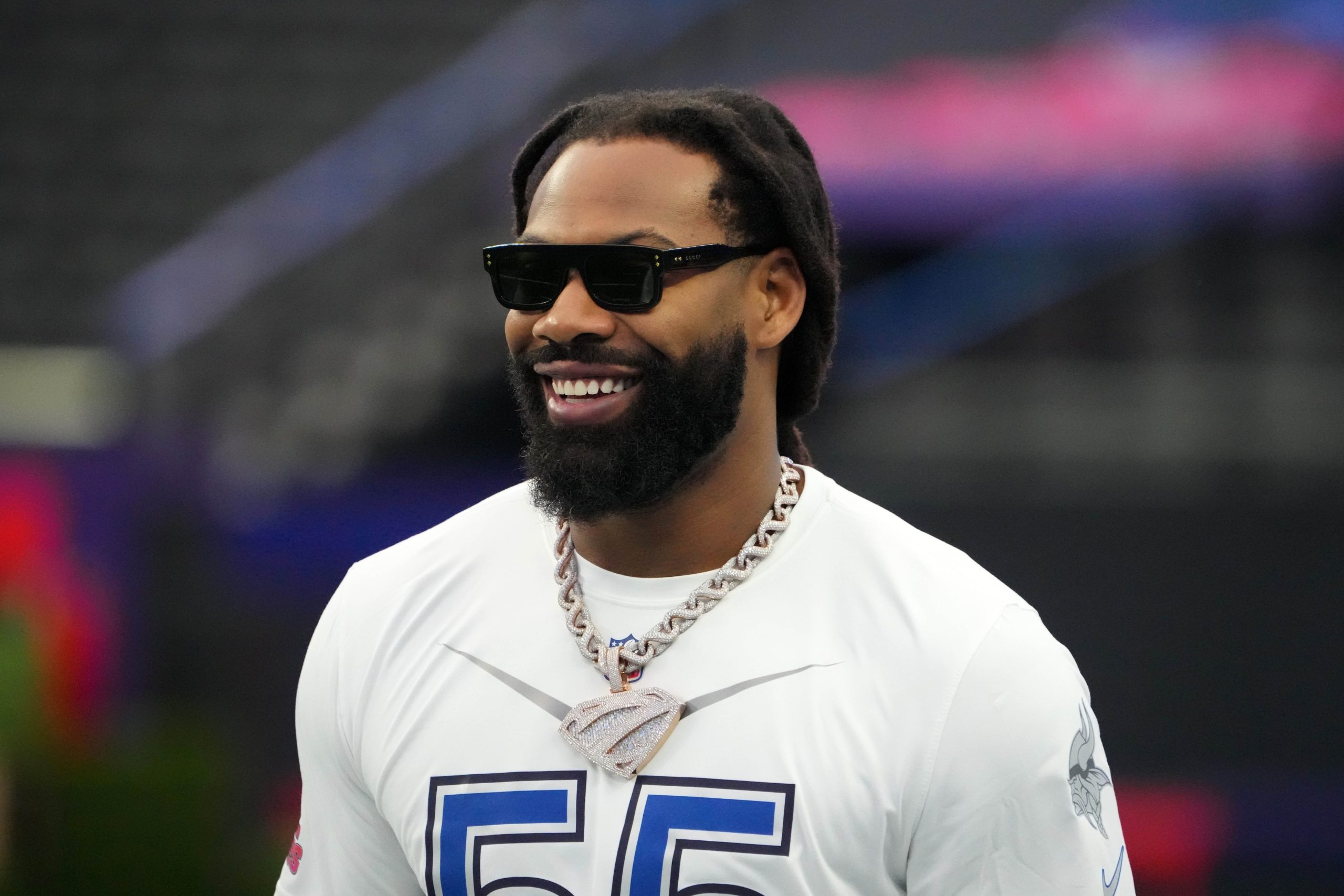
The Detroit Lions’ decision to release veteran pass rusher Za’Darius Smith comes as part of a strategic move to clear salary cap space. While this decision raises many questions for the team’s future, it also reflects broader patterns in the NFL regarding roster management, player contracts, and salary cap manipulation. To understand this release, we need to explore several aspects, including the Lions’ cap situation, Smith’s role with the team, and the larger impact this move could have both on the Detroit Lions and the broader league.
Background on Za’Darius Smith and His Career
Za’Darius Smith entered the NFL as a fourth-round pick in the 2015 draft, selected by the Baltimore Ravens. As a rookie, he showed glimpses of his potential but didn’t become a household name until he joined the Green Bay Packers in 2019. During his time with the Packers, Smith established himself as one of the league’s premier edge rushers, earning two Pro Bowl selections in 2019 and 2020. He finished those seasons with a combined 26 sacks, showcasing both his ability to pressure the quarterback and his consistency as a disruptor in the backfield.
However, Smith’s time with the Packers came to an end after the 2021 season, primarily due to salary cap constraints and his injury history. The Packers traded Smith to the Minnesota Vikings in 2022, where he would spend a season before being released. For many fans and analysts, this was surprising, given that Smith had recorded 9.5 sacks during his one season with Minnesota.
In 2023, the Detroit Lions signed Smith in an attempt to bolster their pass rush. The Lions, under head coach Dan Campbell, were in a phase of transition, looking to build a competitive roster after years of mediocrity. Adding Smith to their defense was seen as a significant move, and he was expected to be a key contributor in the defensive front seven.
The Detroit Lions’ Roster and Cap Space Situation
Before the release of Za’Darius Smith, the Lions were operating in a fairly tight salary cap situation. The NFL’s salary cap system is designed to ensure that teams manage their finances responsibly, but it can sometimes require teams to make tough decisions to maintain roster balance. The Lions’ front office, led by general manager Brad Holmes, had been aggressive in improving the roster, particularly on the defensive side of the ball, through free agency and the draft.
In 2023, the Lions made substantial investments in their defense, including signing veteran players like Smith. However, with the NFL salary cap being a fluid number that teams must constantly manage, the Lions found themselves in a position where freeing up cap space became necessary to ensure they could address other needs on the roster.
Smith’s contract with the Lions included a relatively large cap hit, which likely played a significant role in the decision to release him. By letting go of Smith, the Lions could free up significant financial resources that could be allocated toward re-signing key players, signing free agents, or extending contracts for young talent who would form the foundation of their future. Salary cap flexibility is a critical part of building a competitive team, and this decision allowed the Lions to create room for these moves.
The Reasons Behind the Release
- Cap Space Considerations: As mentioned earlier, the release of Smith was a financial decision. The Lions were likely facing cap space issues and had to choose between keeping Smith and maintaining financial flexibility for other team needs. The NFL salary cap is a crucial factor in roster construction, and teams must balance their spending on high-profile players with other positional needs. The Lions may have determined that releasing Smith would provide more immediate flexibility for the upcoming seasons.
- Declining Performance or Injury Concerns: While Za’Darius Smith had been a productive player over the years, injuries and performance inconsistencies may have played a role in his departure. In the 2022 season, Smith had a solid year with the Vikings, but he had a history of back injuries that raised questions about his long-term durability. Furthermore, while he flashed brilliance at times in Detroit, he may not have met the expectations the Lions had when they signed him. If the coaching staff and front office felt that Smith’s play was declining or that his injury history was a risk, they might have opted to move on and seek a more reliable pass-rushing option.
- Roster Depth and Youth Movement: The Lions had been making moves to improve their pass rush for the future. They had invested in younger players who could develop into key contributors for years to come. The team’s defensive line, while bolstered by Smith in the short term, needed to focus on long-term solutions that fit within the team’s evolving vision. Players like Aidan Hutchinson and other rising stars on the defense may have been given more responsibility, and the front office may have seen Smith as expendable in this context.
- Scheme Fit: A change in defensive philosophy or scheme could have also played a part in Smith’s release. Teams frequently tweak their defensive schemes from year to year based on personnel and coaching philosophy. If the Lions’ defensive system evolved in a way that didn’t maximize Smith’s skill set, this could have influenced the decision to let him go.
Impact on the Detroit Lions
Releasing Za’Darius Smith will certainly have ramifications on the Detroit Lions, both short-term and long-term.
- Defensive Line Depth: Smith’s departure leaves a hole in the Lions’ pass rush, which had already been a key area of concern for the team. While players like Hutchinson had begun to emerge as major threats, Smith’s experience and ability to pressure the quarterback would have been valuable. His release signals that the Lions may have to rely more heavily on younger, developing players or pursue other options through free agency or the draft.
- Financial Flexibility: The immediate impact of the move is the opening up of cap space. This provides the Lions with the flexibility to make more moves, whether in re-signing key players or going after new talent to improve the roster. For a team that is rebuilding and looking to contend in the near future, this move could be a crucial step toward creating a balanced, competitive team.
- Team Culture and Leadership: Za’Darius Smith’s presence in the locker room likely provided valuable leadership and experience, especially for younger players. His departure could leave a leadership void, but it also signals the Lions’ commitment to building a team that relies on emerging talent and not just aging veterans. The leadership transition within the team might present challenges, but it could also open the door for players like Hutchinson to take on larger roles.
- Fan Reactions: Fans are likely to have mixed reactions to Smith’s release. Some may feel disappointed by his departure, given his reputation and what he brought to the field during his time with the Lions. Others may understand the financial reasoning behind the move, recognizing that it could benefit the team in the long run. Overall, the move may create a sense of uncertainty, but it also demonstrates the front office’s willingness to make tough decisions for the greater good of the franchise.
What’s Next for Za’Darius Smith?
Following his release from the Detroit Lions, Za’Darius Smith will undoubtedly attract attention from other NFL teams in need of a pass-rushing specialist. Although his injury history is a concern, his past production and leadership on defense still make him an appealing option for many teams. Several franchises, particularly those with championship aspirations, may view Smith as a valuable piece to strengthen their defensive front. Teams like the Buffalo Bills, Kansas City Chiefs, or even the Green Bay Packers could be potential landing spots for Smith, depending on their cap situation and needs.
Given his proven ability to contribute at a high level when healthy, Smith is unlikely to remain a free agent for long. His next contract will likely be a one- or two-year deal, depending on the interest from competing teams, with performance-based incentives that reward his ability to stay healthy and productive.





